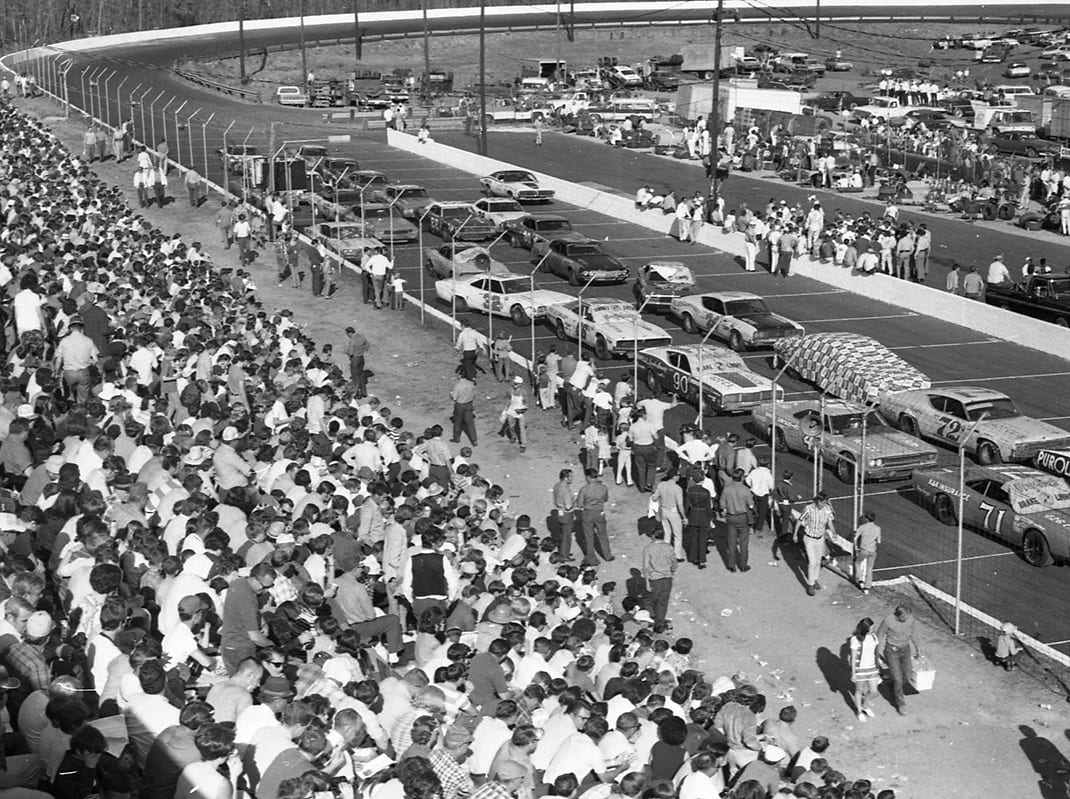Allison remembers the hard work required to keep the cars going night after night, especially when crashes occurred. At times, he had to rely on family and friends in the area to help provide parts and garages in which to work.
“It was so typical because we would take the same car everywhere, whether we crashed, won or blew up,” Allison said. “Somehow we ran all the races. I remember in one race the car was so badly damaged that we had to weld the trunk lid shut to help support the back of the car.
“We didn’t have time to hardly do anything but work on the race car. We missed a meal or two and lost a lot of sleep. It was an incredibly tough schedule, but if you wanted to run for the championship you absolutely had to race where the points were being paid.
“We only had a handful of people helping us and also had to build and prepare new cars for the 500- and 600-mile races on the superspeedways,” Allison noted. “Racing and the travel could be incredibly tough in those days.”
The practice of racing midweek and on weekends continued through 1970. By the fall of that year, the entire complexion of NASCAR radically changed due to a more streamlined, high-profile schedule on the horizon.

With the government prohibiting tobacco from being advertised on television, R.J. Reynolds Tobacco Co. began sinking its advertising budget into motorsports.
Team owner Junior Johnson, a 50-time Cup Series winner as a driver, approached RJR about sponsoring his Chevrolets.
“I started talking to the people at Winston and it wasn’t long at all before they were asking me questions about what else they could do in the sport and how they could take on a bigger role,” Johnson said in the “American Racing Classics” book series. “I told them they really needed to talk to the people in Daytona Beach (NASCAR’s founder Bill France) and before too long went by, Winston had become the series sponsor and we were all chasing the Winston Cup championship.”
Once RJR came into NASCAR as the premier series sponsor in 1971, stock car racing began to find its place among other professional sports. RJR paid lucrative purses, constructed a solid point fund and gave track operators money to upgrade their facilities along with 100,000 gallons of signature Winston red-and-white paint.
RJR financed the building of corporate suites, upgraded press boxes and infield media centers and added electronic scoreboards.
As RJR began its second season as series sponsor in 1972, the schedule was reduced from 48 races to 31, ushering in NASCAR’s modern era. Also, the point system used to crown champions was modified to create a system that was stable and easy to understand.
Races run on dirt tracks and shorter than 250 miles were removed from the schedule. By 1975, a system was implemented with equal points being awarded for all races regardless of length or prize money. Drivers were required to compete in all the races in order to become the series champion. That system remained unchanged from 1975 until the Chase for the Championship was instituted in 2004. Thirty-six Cup Series races have been run annually since 2001.
In an effort to make up races that were postponed early this season, NASCAR began running midweek events in order to cover lost ground.
In addition, two Cup Series races were run on consecutive days, June 27-28. That experiment with doubleheader events was planned prior to the COVID-19 crisis
Team Penske driver Brad Keselowski cites history as helping to cope with the fast-paced schedule.
“Everyone is telling me stories about the ’60s and ’70s when they ran more races,” Keselowski said. “They had the longer schedule and they’d run a 400- or 500-mile race one or two times a week. The drivers would get out halfway. It wasn’t uncommon to where your big-name drivers would run the first 200 or 300 laps, get out, either somebody else would finish the race or they’d get back in and finish the race at the end. I thought that was so interesting.”
Joe Gibbs Racing driver Martin Truex Jr. is prepared to adapt to whatever schedule he faces.
“This whole deal has felt weird — just showing up to the track with no practice and just sort of winging it has felt strange,” Truex said. “At this point, we’ll pretty much do whatever everybody wants to do, and we’ll make it work.”
